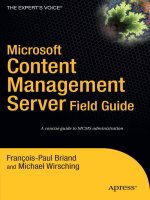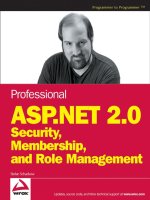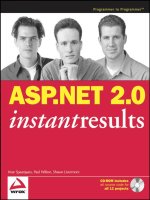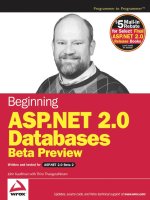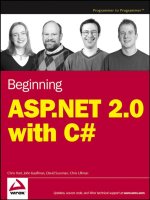- Trang chủ >>
- Đại cương >>
- Kinh tế vĩ mô
enhancing microsoft content management server with asp.net 2.0
Bạn đang xem bản rút gọn của tài liệu. Xem và tải ngay bản đầy đủ của tài liệu tại đây (6.72 MB, 222 trang )
Enhancing Microsoft Content
Management Server with
ASP.NET 2.0
ASP.NET 2.0 Master Pages, Themes, Site
Navigation, and the Membership Provider Model in
Microsoft Content Management Server Development
Use the powerful new features of ASP.NET 2.0 with your
MCMS Websites
Spencer Harbar
Lim Mei Ying
Stefan Goßner
BIRMINGHAM - MUMBAI
Enhancing Microsoft Content Management Server with
ASP.NET 2.0
ASP.NET 2.0 Master Pages, Themes, Site Navigation, and the
Membership Provider Model in Microsoft Content Management
Server Development
Copyright © 2006 Packt Publishing
All rights reserved. No part of this book may be reproduced, stored in a retrieval
system, or transmitted in any form or by any means, without the prior written
permission of the publisher, except in the case of brief quotations embedded in
critical articles or reviews.
Every effort has been made in the preparation of this book to ensure the accuracy of
the information presented. However, the information contained in this book is sold
without warranty, either express or implied. Neither the authors, Packt Publishing,
nor its dealers or distributors will be held liable for any damages caused or alleged to
be caused directly or indirectly by this book.
Packt Publishing has endeavored to provide trademark information about all the
companies and products mentioned in this book by the appropriate use of capitals.
However, Packt Publishing cannot guarantee the accuracy of this information.
First published: July 2006
Production Reference: 1180706
Published by Packt Publishing Ltd.
32 Lincoln Road
Olton
Birmingham, B27 6PA, UK.
ISBN 1-904811-52-3
www.packtpub.com
Cover Image by www.visionwt.com
Credits
Authors
Spencer Harbar
Lim Mei Ying
Stefan Goßner
Reviewers
Andreas Klein
Mick Badran
Chester Ragel
Joel Ward
Development Editor
Douglas Paterson
Technical Editor
Niranjan Jahagirdar
Editorial Manager
Dipali Chittar
Indexer
Mithil Kulkarni
Proofreader
Chris Smith
Production Coordinator
Manjiri Nadkarni
Layouts and Illustrations
Shantanu Zagade
Cover Designer
Shantanu Zagade
About the Authors
Spencer Harbar, an MCSD for Microsoft .NET, MCSE and MVP for MCMS, has
over twelve years commercial experience of architecture, design, development,
deployment, and operational support of web-based applications and hosting
platforms for some of Europe’s largest organisations.
Spencer maintains www.mcmsfaq.com: an MCMS resources portal, and is active in the
public newsgroups. His experience of MCMS goes back to the days of NCompass
Resolution, and he has been involved in many enterprise implementations.
Currently working as an independent consultant, Spencer delivers enterprise content
management and portal systems architecture, design, development, and deployment
solutions, application security best practices, threat modeling, and the implementation
of highly available Windows-Server-System-based hosting platforms.
Product expertise includes MCMS, SharePoint Technologies, IIS, SQL Server,
Commerce Server and BizTalk Server, Windows Security, PKI, and High Availability.
Selected clients include Barclays Bank, Scottish Power plc, HBOS, Microsoft,
The Royal Bank of Scotland, Scottish Enterprise, Centrica, Clifford Chance, The
Automobile Association, and BASF.
Spencer resides in Edinburgh, UK.
Lim Mei Ying is a Senior Consultant with Avanade and has extensive experience
in setting up MCMS systems at the enterprise level. She has spent many hours
guring out the dos and don’ts of the product, and enjoys nding new ways to solve
MCMS-related problems.
She contributes actively to the newsgroup community and is a Microsoft Most
Valuable Professional for Content Management Server. Mei Ying lives on the sunny
island of Singapore and blogs at . She also co-
authored the earlier book, Building Websites with Microsoft Content Management Server
(ISBN 1-904811-16-7, Packt Publishing).
Thanks to my husband, Louis, for the much needed support throughout
the many months of writing. Special thanks to my family and friends for
their encouragement.
Stefan Goßner works for Microsoft as an Escalation Engineer in the Developer
Support department. He provides customers with technical solutions to problems
related to Microsoft Internet Server Products. Stefan has a wide understanding of all
areas of MCMS.
His contributions to the newsgroup have helped many people to implement MCMS
solutions in corporations around the globe to the point where it has been said that if
you don’t know Stefan, then you’re probably new to MCMS.
Stefan maintains a huge MCMS 2002 FAQ on the Microsoft website,
and provides MCMS tips and tricks on his personal blog
Stefan has also written the books Building Websites With Microsoft Content Management
Server (ISBN 1-904811-16-7, Packt Publishing), and Advanced Microsoft Content
Management Server Development (ISBN 1-904811-53-1, Packt Publishing).
He lives in Munich, Germany, and can be reached at
I would like to thank my girlfriend Michaela, for her support throughout
months of writing, reviewing, and coding for the book. Also many thanks
to my friends in the MCMS Support Teams worldwide and to my friends
in the MCMS product team in the US.
About the Reviewers
Andreas Klein started in the PC business in 1981, working as a consultant for
several years before joining Microsoft in 1990. Since then he has held programming
trainings. On the technical side, he has covered many different areas, including
Win16 (Windows 2.x, 3.x) and Win32 Application and Driver Programming, helping
customers manage their systems running Windows 9x, Windows NT, and later
versions, and even Exchange 4.0 - 2000.
His current focus is web server scenarios (IIS, MCMS 2002), DHTML programming,
and PKI/Security concepts in the IT scope.
Mick Badran has been performing Microsoft technical classroom-based training for
more than nine years, and has over 12 years commercial development experience in
various languages. Mick has been consulting for Microsoft in areas of CMS, SPS, and
BizTalk for over ve years. He also specializes in customized training in these areas.
Mick speaks at various Microsoft Events such as TechEd and Security summits, and
is a BizTalk MVP.
He can be reached at , and would love to hear
your feedback.
Joel Ward works as a web developer and technical manager. Once destined to be
an architect, he switched tracks midway through college and instead graduated with
a degree in Integrative Arts from the Pennsylvania State University. His professional
career has taken him on a journey through design, programming, usability,
and accessibility.
Joel has enjoyed working with MCMS since its rst release in 2001. Over the years,
Joel has been active in the newsgroups and has been recognized as a Microsoft Most
Valuable Professional for his work in the MCMS community.
He enjoys a good challenge, which includes working on projects that use ASP.NET,
MCMS, and SharePoint.
Joel lives in the Commonwealth of Virginia in the United States. You can visit his
website at
Table of Contents
Preface 1
Chapter 1: Installation 7
Overview of MCMS 2002 Service Pack 2 7
Obtaining MCMS Service Pack 2 8
Installation Approach 9
Upgrading to Microsoft Content Management Server 2002
Service Pack 2 9
Installing Visual Studio 2005 10
Installing MCMS 2002 Service Pack 2 13
Conguring the Development Environment 15
Site Manager Shortcut 15
Visual Studio Templates 16
Preparing the MCMS Database for SQLServer 2005 17
Upgrading SQL Server 2005 18
Installing SQL Server 2005 Service Pack 1 25
Modifying the CreateBackgroundProcessingJob Stored Procedure 26
Fresh Installation of Microsoft Content Management Server 2002
Service Pack 2 26
Conguring Local Security Policy 27
Creating Service Accounts 28
Installing Internet Information Services 30
Conguring Internet Information Services 32
Installing SQL Server 2005 33
Installing SQL Server 2005 Service Pack 1 40
Conguring SQL Server 2005 40
Bypass the Installation of Visual Studio.NET 2003 43
Installing MCMS 2002 Prerequisites 44
J# 2.0 Redistributable 44
Internet Explorer Web Controls for MCMS 45
[ ii ]
Table of Contents
Installing MCMS 2002 SP1a 45
Remove Temporary Items 49
Install Visual Studio 2005 49
Install MCMS SP2 52
Conguring the Development Environment 54
Site Manager Shortcut 55
Visual Studio Templates 55
Run the Database Conguration Application 56
Remove Visual Studio.NET 2003 64
Known Issues with MCMS SP2 Installation 64
Installation Tips 65
Installing MCMS SP2 on Windows Server 2003 X64 Edition 65
Installing the Required SQL Server 2005 Components 65
Summary 66
Chapter 2: Getting Started with the Development Environment 67
Visual Web Developer Websites 67
Creating an MCMS Web Application 68
Checking the Website Conguration Settings in IIS 71
Developing MCMS Web Applications 73
Correcting Basic.aspx 74
Conguring the 'CMS' Virtual Directory 76
Creating Custom MCMS Application Templates 78
Summary 87
Chapter 3: Using Master Pages 89
Overview and Benets of Master Pages 89
The TropicalGreen Website 91
Importing the TropicalGreen Site Deployment Object File 92
Creating a New MCMS Web Application 92
Creating a Master Page for Use with MCMS 93
Creating an MCMS Template File Based on a Master Page 98
Modifying Master Page Properties from the Template File 102
Summary 103
Chapter 4: Navigation Controls 105
Navigation for TropicalGreen 106
Site Maps and Site-Map Providers 107
Building an MCMS Site-Map Provider 108
The MCMSSiteMapProvider Class 108
Implementing the GetRootNodeCore() Method 110
[ iii ]
Table of Contents
Implementing the FindSiteMapNode() Method 111
Enhancing the Searches.GetByUrl() Method 112
Implementing the GetParentNode() Method 113
Implementing the GetChildNodes() Method 117
Registering the SiteMapProvider 118
The SiteMapPath Control 118
The Menu Control 119
Building a Horizontal Menu 119
Using Custom Properties to Differentiate Between Top and Right Menu Items 121
The MCMSSiteMapProviderTop Class 122
Building a Dynamic Multi-Level Vertical Menu 125
The MCMSSiteMapProviderRight Class 125
The TreeView Control 129
The Site Map Page 130
Populating Nodes on Demand 134
Removing the Leave Warning Message When Expanding Nodes in Edit Mode 136
Getting the Populate-On-Demand Feature of the
TreeView Control to Work in Channel-Rendering Scripts 139
Using the TreeView Control in Summary Pages 142
The SiteMapProviderSummary Class 143
Conguring the TreeView Control to Display a Flat Listing of Items 145
Summary 147
Chapter 5: Applying Themes 149
Themes versus Cascading Style Sheets 149
Creating a Theme 150
Applying a Theme to the Entire Site 151
Skins for Server Controls 151
Creating a Default Skin 152
Creating a Name-Controlled Skin 154
Completing the Skin 155
Using Style Sheets 156
Creating a Style Sheet 156
Why Themes with Style Sheets May Not Work on MCMS Sites 158
Applying Themes when the RenderBaseHref Property is Disabled 160
Creating the CorrectThemes HTTP Module 161
Summary 164
Chapter 6: Authentication Controls and Membership Providers 165
Authentication Controls 165
Implementing an MCMS Membership Provider 167
Using an MCMS Membership Provider 174
[ iv ]
Table of Contents
Creating a Login Page Using the Login Control 175
Using the LoginStatus and LoginName Controls 178
Supporting Custom Authentication Schemes 181
Summary 182
Chapter 7: How-Tos, Tips, and Tricks 183
Tip #1: How to Perform Cross-Page Postbacks 183
Passing Data Between Pages 184
The "Order a Plant" Wizard 185
The Ordering Page 186
The Checkout Screen 190
Adding the "Order Plants" Menu Item 192
Why Cross-Page Postbacks Do Not Work on MCMS Sites 193
The CorrectCrossPostBack HTTP Module 196
Tip #2: How to Implement an Ad Rotator 198
The MCMSAdRotator 199
Tip #3: Considerations for Microsoft Ofce SharePoint Server 2007 202
Isolate Code that Uses the PAPI into Modules 203
Use the Provider Model Design Pattern 206
Summary 206
Index 207
Preface
Enhancing Microsoft Content Management Server with ASP.NET 2.0 delves into the
integration of key ASP.NET 2.0 features such as Master Pages, Site Navigation,
Themes and Skins, and the Membership Provider Model with Microsoft Content
Management Server 2002 (MCMS) Service Pack 2.
Each chapter builds upon the last, walking through these new features available
to MCMS developers and building a sample site similar to that presented in our
previous book, Building Websites with Microsoft Content Management Server from Packt
Publishing January 2005 (ISBN 1-904811-16-7)
What This Book Covers
Chapter 1 walks you through the installation and conguration of MCMS 2002
Service Pack 2 (SP2), along with SQL Server 2005 and Visual Studio 2005 on a single
developer workstation. There are two approaches to setting up a development
environment for SP2: an upgrade from a previous SP1a installation or starting
from scratch and building a fresh installation including SP2. We will cover both
approaches in this chapter.
In Chapter 2 we spend some time getting familiar with the MCMS Service Pack 2
development environment, which is slightly different from what we are used to with
previous versions of MCMS and Visual Studio. We will cover these changes and a
number of tips for working within the SP2 development environment, such as the
creation of custom MCMS Visual Studio 2005 templates.
Chapter 3 introduces you to one of the best new features introduced with ASP.NET
2.0, master pages, which allow developers to enforce common layout and behavior
across pages within an application. While at rst pass many master pages concepts
are similar to those of MCMS templates, there are a number of benets to be gained
by taking advantage of master pages within MCMS applications. This chapter
[ 2 ]
Preface
provides an overview of the benets of using master pages and a step-by-step
guide for implementing them in your MCMS applications, where they become
master templates!
Chapter 4 covers the new ASP.NET 2.0 Navigation provider model and controls, and
how to integrate them into your MCMS applications. Developing site navigation
controls is an exercise that often leaves developers in a dilemma. Early versions of
Visual Studio did not provide any ready-to-use navigation controls. Developers had
to choose between spending many hours building controls from scratch or expand
project budgets to purchase shrink-wrapped software.
In Chapter 5 we will see how a common look and feel can be applied efciently to
an MCMS site by using themes. We will create skins and cascading style sheets and
demonstrate how they work together to dene the appearance of a site. Finally, we
will discuss an essential customization required for themes to work correctly in an
MCMS site.
Chapter 6 covers the Membership Provider Model, one of the key new concepts
introduced with ASP.NET 2.0, which makes it signicantly easier to develop web
applications that utilize third-party or custom membership stores. In addition
ASP.NET 2.0 ships with a number of authentication controls related to role
membership, which vastly reduce the amount of code required to implement forms
authentication and associated functionality in your applications. This chapter shows
how to use these features to improve the implementation of Forms Authentication
and provides a more elegant solution for "account mapping" scenarios whereby
authentication takes place against an external store and the accounts are mapped to
Windows accounts for the purposes of MCMS authorization.
In Chapter 7 we present a number of tips along with code samples for working with
ASP.NET 2.0 and MCMS SP2, and offer implementation advice for those considering
migration to the upcoming Microsoft Ofce SharePoint Server 2007.
What You Need for This Book
This book has been written for MCMS developers who are comfortable with the
material presented in our previous book, Building Websites with Microsoft Content
Management Server, and have a solid grasp of C#. To use this book you need to have
access to the following:
Visual Studio 2005 (any edition).
Microsoft Content Management Server 2002 Service Pack 2
(any edition). A 120 day evaluation of MCMS is available from
/>•
•
[ 3 ]
Preface
We walk through the various pre-requisites for installation in Chapter 1. All
examples presented use Microsoft Windows XP Professional Service Pack 2.
Conventions
In this book, you will nd a number of styles of text that distinguish between
different kinds of information. Here are some examples of these styles, and an
explanation of their meaning.
There are three styles for code. Code words in text are shown as follows: "We can
include other contexts through the use of the include directive."
A block of code will be set as follows:
public string FirstName
{
get
{
return txtFirstName.Text.Trim();
}
}
// Last Name
public string LastName
{
get
{
return txtLastName.Text.Trim();
}
}
When we wish to draw your attention to a particular part of a code block, the
relevant lines or items will be made bold:
public string FirstName
{
get
{
return txtFirstName.Text.Trim();
}
}
// Last Name
public string LastName
{
get
[ 4 ]
Preface
{
return txtLastName.Text.Trim();
}
}
Any command-line input and output is written as follows:
xcopy "MCMS_INSTALL_PATH\DevTools\NewProjectWizards80\Visual Web
Developer" "PATH_TO_MY_DOCUMENTS_FOLDER\Visual Studio 2005\Templates\
ProjectTemplates\Visual Web Developer"/E
New terms and important words are introduced in a bold-type font. Words that you
see on the screen, in menus or dialog boxes for example, appear in our text like this:
"clicking the Next button moves you to the next screen".
Warnings or important notes appear in a box like this.
Tips and tricks appear like this.
Reader Feedback
Feedback from our readers is always welcome. Let us know what you think about
this book, what you liked or may have disliked. Reader feedback is important for us
to develop titles that you really get the most out of.
To send us general feedback, simply drop an email to ,
making sure to mention the book title in the subject of your message.
If there is a book that you need and would like to see us publish, please send us a
note in the SUGGEST A TITLE form on www.packtpub.com or email suggest@
packtpub.com.
If there is a topic that you have expertise in and you are interested in either writing
or contributing to a book, see our author guide on www.packtpub.com/authors.
Customer Support
Now that you are the proud owner of a Packt book, we have a number of things to
help you to get the most from your purchase.
[ 5 ]
Preface
Downloading the Example Code for the Book
Visit and select this book from the list of titles
to download any example code or extra resources for this book. The les available
for download will then be displayed.
The downloadable les contain instructions on how to
use them.
Errata
Although we have taken every care to ensure the accuracy of our contents, mistakes
do happen. If you nd a mistake in one of our books—maybe a mistake in text or
code—we would be grateful if you would report this to us. By doing this you can
save other readers from frustration, and help to improve subsequent versions of this
book. If you nd any errata, report them by visiting />support, selecting your book, clicking on the Submit Errata link, and entering the
details of your errata. Once your errata have been veried, your submission will be
accepted and the errata added to the list of existing errata. The existing errata can be
viewed by selecting your title from />Questions
You can contact us at if you are having a problem with
some aspect of the book, and we will do our best to address it.
Installation
In this chapter we walk you through the installation and conguration of MCMS
2002 Service Pack 2 (SP2), along with SQL Server 2005 and Visual Studio 2005 on
a single developer workstation. In addition, we will cover the changes to the SP2
development environment and a number of tips for working within it.
This chapter assumes you are already familiar with the steps necessary to install MCMS
2002 SP1a as detailed in depth in the previous book, Building Websites with Microsoft
Content Management Server from Packt Publishing, January 2005 (ISBN 1-904811-16-7).
There are two approaches to setting up a development environment for SP2:
upgrading from a previous SP1a installation, or starting from scratch and building a
fresh installation including SP2. We will cover both approaches in this chapter.
For the examples in this book, we will be using Windows XP Professional SP2 as
our development workstation. However, where there are signicant differences for
a Windows Server 2003 SP1 machine, those will be noted. All examples assume the
logged-on user is a local machine administrator.
Overview of MCMS 2002 Service Pack 2
As with other Microsoft Service Packs, one major purpose of SP2 is to provide an
integrated installation for a large number of previously released hotxes. SP2 will
now be a prerequisite for any future hotx releases.
While many customers will view SP2 as a regular Service Pack, it also offers support
for the latest development platform and tools from Microsoft, namely SQL Server
2005, .NET Framework 2.0 and ASP.NET 2.0, and Visual Studio 2005:
SQL Server 2005: MCMS databases can be hosted by SQL Server 2005,
offering numerous advantages in security, deployment, and most
signicantly, performance.
•
Installation
[ 8 ]
.NET Framework 2.0 and ASP.NET 2.0: MCMS applications can be hosted
within the .NET Framework 2.0 runtime, and take advantage of v2.0
language features as well as security and performance improvements. In
addition, many of the new features of ASP.NET 2.0 such as master pages,
themes, navigation, and Membership Providers can be used. This provides
numerous opportunities to both rene and refactor MCMS applications, and
is the primary focus of this book.
Visual Studio 2005: MCMS applications can be developed using Visual
Studio 2005. One of the greatest advantages here is the use of the new
HTML-editing and designer features in VS.NET along with improved
developer productivity.
If you wish, you can continue to use SQL Server 2000 for your MCMS applications.
However, we recommend upgrading to SQL Server 2005 and will use it throughout
the examples in this book.
There are numerous versions or Stock Keeping Units (SKUs) of Visual Studio 2005,
all of which are supported with SP2. Throughout the examples in this book, we will
be using Visual Studio 2005 Professional Edition.
Unfortunately, SP2 is not a cumulative service pack and
therefore requires an existing installation of SP1a. Likewise,
there is no slipstreamed distribution of SP2. The SP2
distribution is suitable for all editions of MCMS.
Mainly due to the extremely fast preparation and release of SP2 following the
Release to Manufacturing (RTM) of .NET 2.0, Visual Studio 2005, and SQL Server
2005, the Microsoft installation information (KB906145) isn’t particularly well
documented and is somewhat confusing. Rest assured that the guidance in this
chapter has been veried and tested for both installation scenarios covered.
Obtaining MCMS Service Pack 2
MCMS SP2 can be downloaded from the following locations:
English:
3DE1E8F0-D660-4A2B-8B14-0FCE961E56FB&displaylang=en
French:
3DE1E8F0-D660-4A2B-8B14-0FCE961E56FB&displaylang=fr
•
•
•
•
Chapter 1
[ 9 ]
German:
3DE1E8F0-D660-4A2B-8B14-0FCE961E56FB&displaylang=de
Japanese:
3DE1E8F0-D660-4A2B-8B14-0FCE961E56FB&displaylang=ja
Installation Approach
We cover both an in-place upgrade to SP2 and a fresh installation in this chapter.
Which approach you take is down to your specic requirements and your current, if
any, MCMS installation.
If you wish to upgrade, continue with the next section, Upgrading to Microsoft Content
Management Server 2002 Service Pack 2 and then skip ahead to Chapter 2, Getting
Started with the Development Environment.
If you wish to perform a fresh install, skip ahead to the Fresh Installation of Microsoft
Content Management Server 2002 Service Pack 2 section, about 18 to 20 pages into
this chapter.
Upgrading to Microsoft Content
Management Server 2002 Service Pack 2
This section details the steps required to upgrade an existing installation of MCMS
SP1a, which includes the Developer Tools for Visual Studio.NET 2003 component.
The outline process for an upgrade is as follows:
1. Install Visual Studio 2005.
2. Install MCMS 2002 Service Pack 2.
3. Congure the development environment.
4. (Optional) Prepare the MCMS database for SQL Server 2005.
5. (Optional) Upgrade SQL Server.
6. (Optional) Install SQL Server 2005 Service Pack 1.
We will perform all steps while logged on as a local machine administrator.
•
•
Installation
[ 10 ]
Installing Visual Studio 2005
Visual Studio 2005 can be installed side by side with Visual Studio.NET 2003. Once
we have completed the upgrade, we can remove Visual Studio.NET 2003 if we wish
to only develop MCMS applications using SP2 and ASP.NET 2.0.
1. Insert the Visual Studio 2005 DVD, and on the splash screen, click Install
Visual Studio 2005.
2. On the Welcome to the Microsoft Visual Studio 2005 installation wizard
page, click Next.
3. On the Start Page, select the I accept the terms of the License Agreement
checkbox, enter your Product Key and Name, and click Next.
4. On the Options Page, select the Custom radio button, enter your desired
Product install path, and click Next.
Chapter 1
[ 11 ]
5. On the second Options page, select the Visual C# and Visual Web
Developer checkboxes within the Language Tools section, and the Tools
checkbox within the .NET Framework SDK section. Click Install.
Feel free to install any additional features you may wish to
use. The above selections are all that’s required to follow
the examples in this book.
Installation
[ 12 ]
6. Wait (or take a coffee break) while Visual Studio 2005 is installed. When the
Finish Page appears, click Finish.
7. From the Visual Studio 2005 Setup dialog, you can choose to install the
Product Documentation (MSDN Library) if desired.
8. From the Visual Studio 2005 Setup dialog, click Check for Visual Studio
Service Releases to install any updates that may be available.
9. Click Exit.
Chapter 1
[ 13 ]
Installing MCMS 2002 Service Pack 2
Next, we will install MCMS Service Pack 2.
1. From the Start Menu, click Run…
2. In the Open textbox, enter IISRESET /STOP and click OK. Wait while the IIS
Services are stopped.
3. Double-click the SP2 installation package.
4. On the Welcome to Microsoft Content Management Server 2002 SP2
Installation Wizard page, click Next.
Installation
[ 14 ]
5. Select the I accept the terms of this license agreement radio button, and
click Next.
6. On the ready to begin the installation page, click Next.
Wait while Service Pack 2 is installed.
